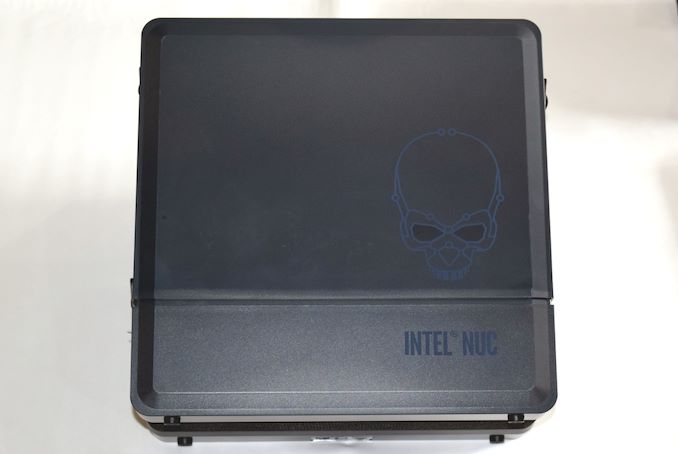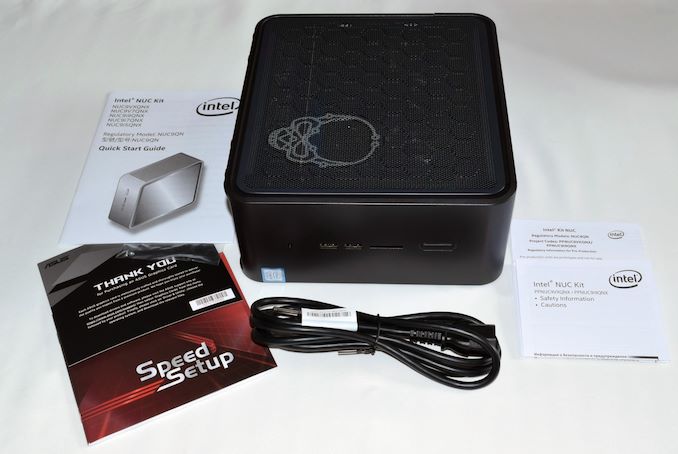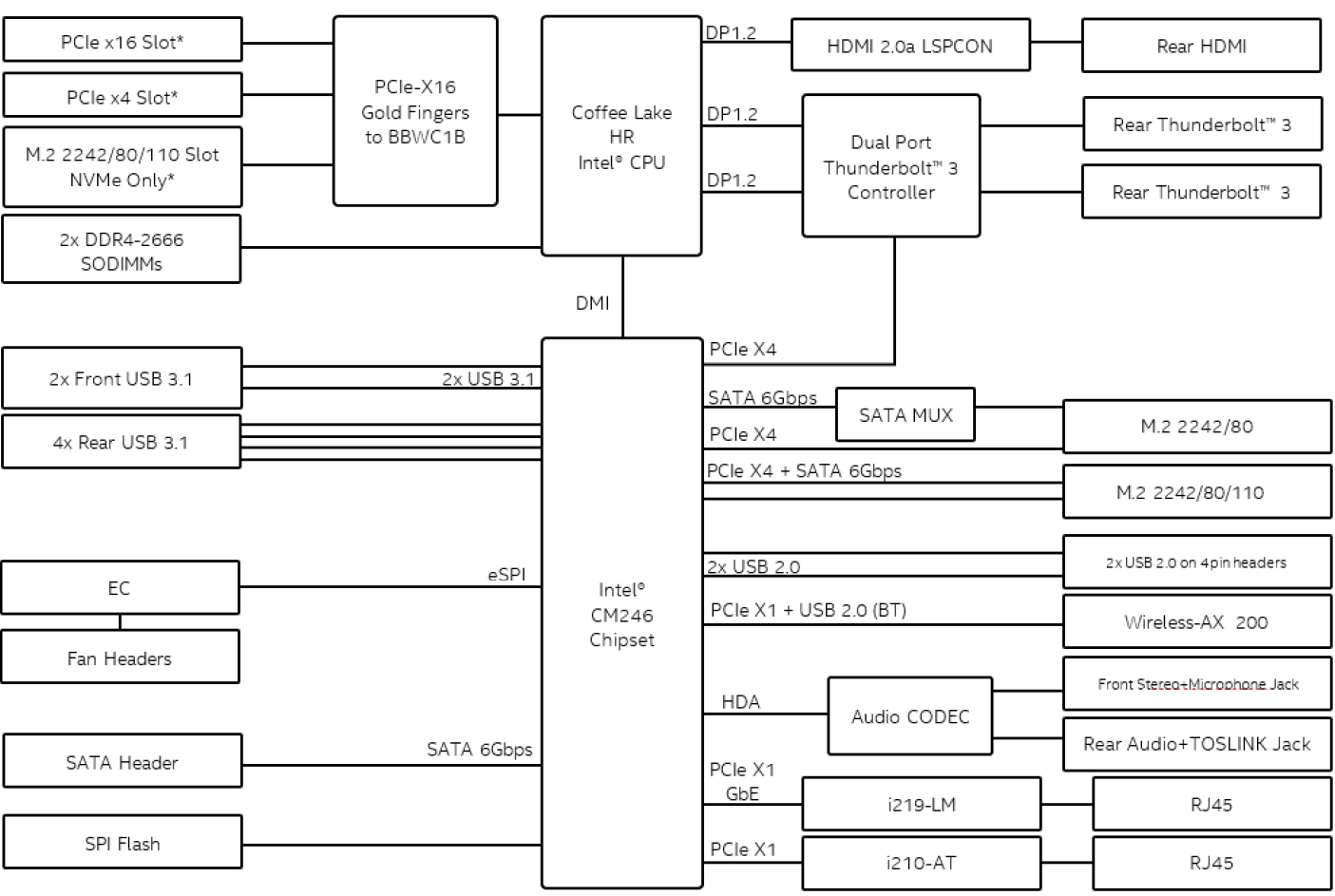Intel Ghost Canyon NUC9i9QNX Review: NUC 9 Extreme Realizes the SFF Dream
by Ganesh T S on April 16, 2020 8:05 AM ESTSetup Notes and Platform Analysis
The NUC 9 Extreme Kit is packaged in a fancy hard casing, signifying its premium nature. Since we had a system configuration essentially ready to benchmark, the package contents only included a few manuals and regulatory information notes along with a US power cord.
We noted the re-design of the Visual BIOS in our Frost Canyon NUC review. The NUC9i9QNX also uses the same re-designed interface. Unlike the mainstream NUC10i7FNH, the NUC9i9QNX has a few enthusiast options including the ability to fine-tune the DRAM timing parameters from a performance perspective. The entire gamut of options available in the latest BIOS (v0034) of the NUC9i9QNX is brought out in the gallery below.
The specifications of our Intel NUC9i9QNX review configuration are summarized in the table below.
| Intel NUC9i9QNX (Ghost Canyon) Specifications | |
| Processor | Intel Core i9-9980HK Coffee Lake-H, 8C/16T, 2.4 (5.0) GHz 16MB L2+L3, 14nm (optimized), 45W TDP |
| Memory | Kingston HyperX KHX3200C20S4/8G DDR4 SODIMM 17-19-19-35 @ 2666 MHz 2x8 GB |
| Graphics | ASUS Dual GeForce RTX 2070 MINI 8GB GDDR6 Intel UHD Graphics 630 |
| Disk Drive(s) | Intel SSD 905p Optane SSDPEL1D380GA (380 GB; M.2 Type 22110 PCIe 3.0 x4 NVMe; Optane / 3D XPoint) Kingston KC2000 SKC2000M81000G (1TB; M.2 Type 2280 PCIe 3.0 x4 NVMe; Toshiba 96L 3D TLC; Silicon Motion SM2262EN Controller) |
| Networking | Intel Wi-Fi 6 AX200 (2x2 802.11ax - 2400 Mbps) 1x Intel I219-LM Gigabit Ethernet Adapter 1x Intel I210 Gigabit Ethernet Adapter |
| Audio | 3.5mm Audio Jack (Front) Optical TOSLINK output (Rear) Capable of 5.1/7.1 digital output with HD audio bitstreaming (HDMI) |
| Miscellaneous I/O Ports | 1x UHS-II SDXC Slot (Front) 2x USB 3.2 Gen 2 (10 Gbps) Type-A (Front) 4x USB 3.2 Gen 2 (10 Gbps) Type-A (Rear) 2x Thunderbolt 3 (40 Gbps) Type-C (Rear) |
| Operating System | Retail unit is barebones, but we installed Windows 10 Enterprise x64 |
| Pricing (As configured) | $2810 |
| Full Specifications | Intel NUC9i9QNX Specifications |
The block diagram of the components of the NUC9i9QNX are presented in the diagram below.
One of the aspects that needs to be pointed out here is that the 2x Front USB 3.1 ports specified in the diagram above are physically the ones on the Compute Element, and not on the front panel of the chassis. The diagram does bring out the PCIe lanes bifurcation in the baseboard, though.
Our review sample came with Windows 10 Home x64 pre-installed, but, we wiped the drive and installed Windows 10 Enterprise x64 1909 along with the March 2020 cumulative updates prior to benchmarking. Our initial benchmarking and reports collection was done without opening up the system. The AIDA64 system report for the hardware configuration supplied by Intel provided the following information:
- [ North Bridge: Intel Comet Lake-H IMC ]:
- PCIe 3.0 x8 port #2 In Use @ x8 (nVIDIA GeForce RTX 2070 Video Adapter, nVIDIA TU106 - High Definition Audio Controller)
- PCIe 3.0 x4 port #4 In Use @ x4 (Intel Optane SSD 900p NVMe Controller)
- [ South Bridge: Intel Cannon Point CM246 ]:
- PCIe 3.0 x1 port #1 In Use @ x1 (Intel Wi-Fi 6 AX200 160MHz Wireless Network Adapter)
- PCIe 3.0 x4 port #5 In Use @ x4 (Intel Titan Ridge Thunderbolt 3 Controller)
- PCIe 3.0 x4 port #9 In Use @ x4 (Silicon Motion SM2262 PCIe 3.0 x4 NVMe 1.3 SSD Controller - Kingston KC2000)
- PCIe 3.0 x1 port #14 In Use @ x1 (Intel I210 Gigabit Network Connection)
We were puzzled by the discrete GPU operating in x8 mode instead of x16 (as it could affect gaming performance). After reaching out to Intel, we got additional context for the review configuration. As noted briefly a bit earlier, the M.2 slot on the baseboard is directly attached to the CPU, using PCIe lanes from it rather than off of the chipset. So the power-hungry, but high-performance 905p Optane drive in the baseboard slot makes sense in that context, as Intel is giving it the best possible (and least contested) connection to the CPU in order to highlight the capabilities of CPU-attached storage.
As evident from the block diagram, the Thunderbolt ports, USB ports, and the M.2 slots on the Compute Element are attached to the chipset, which means sharing the DMI link and its maximum bandwidth of PCIe 3.0 x4 (4GB/s). Which compared to typical systems, is actually a lighter load than usual; by hanging the Optane drive off of the CPU, there's less contention for the rest of the DMI link's resources, enabling additional testing areas such as elimination of noise from Thunderbolt 3 testing and allowing for RAID-0/1 on the Compute Element. Overall this opens up a few different configuration options, so in order to highlight the pros and cons of splitting the x16 slot with a SSD, we also tested the NUC with the Optane drive hanging off of the PCH, giving the video card a full x16 slot's worth of bandwidth. This is noted as x16 in the rest of the review to signify the operation of the RTX 2070 in x16 mode.
The AIDA64 system report for the x16 configuration has a slightly tweaked version of the PCIe lane usage specified earlier:
- [ North Bridge: Intel Comet Lake-H IMC ]:
- PCIe 3.0 x16 port #2 In Use @ x8 (nVIDIA GeForce RTX 2070 Video Adapter, nVIDIA TU106 - High Definition Audio Controller)
- [ South Bridge: Intel Cannon Point CM246 ]:
- PCIe 3.0 x1 port #1 In Use @ x1 (Intel Wi-Fi 6 AX200 160MHz Wireless Network Adapter)
- PCIe 3.0 x4 port #5 In Use @ x4 (Intel Titan Ridge Thunderbolt 3 Controller)
- PCIe 3.0 x4 port #9 In Use @ x4 (Intel Optane SSD 900p NVMe Controller)
- PCIe 3.0 x1 port #14 In Use @ x1 (Intel I210 Gigabit Network Connection)
- PCIe 3.0 x4 port #21 In Use @ x4 (Silicon Motion SM2262 PCIe 3.0 x4 NVMe 1.3 SSD Controller - Kingston KC2000)
The NUC9i9QNX is a relatively unique system. We have evaluated SFF systems with discrete GPUs in the last few years. Systems such as the Hades Canyon NUC came with a co-packaged discrete GPU leaving no scope for the end-user to upgrade the graphics performance without buying an entirely new computer. We've also had systems with a real discrete GPU such as the ASRock DeskMini Z370 GTX1060 and the Zotac ZBOX MAGNUS EN1080K. Theoretically, users could upgrade the installed MXM card to get better graphics performance, but practically speaking, MXM card upgrades are incredibly rare and almost never officially supported by system manufacturers.
This leaves us with one true precursor to the Ghost Canyon NUC - the Zotac ZBOX MAGNUS EK71080. This 5.7L compact gaming powerhouse internally sports a single-fan version of the Zotac GTX 1080 Mini complete with the external PCIe power connector, and nothing preventing the end-user from replacing it with a similar-sized GPU. Obviously, Zotac would not officially support this, but it only serves to show that accommodation of user-replaceable discrete GPUs in compact SFF systems has been possible before. The Compute Element initiative from Intel has been accompanied by the creation of an ecosystem where add-in card vendors now have an incentive to create discrete GPU cards within the 202mm x 131mm form-factor. Along with chassis designs like the one in the NUC9i9QNX, this has now enabled sub-5L systems capable of sporting powerful user-replaceable discrete GPUs.
In the table below, we have an overview of the various systems that we are comparing the Intel NUC9i9QNX against. Note that they may not belong to the same market segment. The relevant configuration details of the machines are provided so that readers have an understanding of why some benchmark numbers are skewed for or against the Intel NUC9i9QNX when we come to those sections.
| Comparative PC Configurations | ||
| Aspect | Intel NUC9i9QNX (Ghost Canyon) | |
| CPU | Intel Core i9-9980HK | Intel Core i9-9980HK |
| GPU | ASUS Dual GeForce RTX 2070 MINI 8GB GDDR6 Intel UHD Graphics 630 |
ASUS Dual GeForce RTX 2070 MINI 8GB GDDR6 Intel UHD Graphics 630 |
| RAM | Kingston HyperX KHX3200C20S4/8G DDR4 SODIMM 17-19-19-35 @ 2666 MHz 2x8 GB |
Kingston HyperX KHX3200C20S4/8G DDR4 SODIMM 17-19-19-35 @ 2666 MHz 2x8 GB |
| Storage | Intel SSD 905p Optane SSDPEL1D380GA (380 GB; M.2 Type 22110 PCIe 3.0 x4 NVMe; Optane / 3D XPoint) Kingston KC2000 SKC2000M81000G (1TB; M.2 Type 2280 PCIe 3.0 x4 NVMe; Toshiba 96L 3D TLC; Silicon Motion SM2262EN Controller) |
Intel SSD 905p Optane SSDPEL1D380GA (380 GB; M.2 Type 22110 PCIe 3.0 x4 NVMe; Optane / 3D XPoint) Kingston KC2000 SKC2000M81000G (1TB; M.2 Type 2280 PCIe 3.0 x4 NVMe; Toshiba 96L 3D TLC; Silicon Motion SM2262EN Controller) |
| Wi-Fi | Intel Wi-Fi 6 AX200 (2x2 802.11ax - 2400 Mbps) |
Intel Wi-Fi 6 AX200 (2x2 802.11ax - 2400 Mbps) |
| Price (in USD, when built) | $1553 (barebones) $2810 (as configured) |
$1553 (barebones) $2810 (as configured) |



















109 Comments
View All Comments
PeachNCream - Thursday, April 16, 2020 - link
NUCs have usually had a bit of a markup, but the price here is quite a bit higher than one would expect.Deicidium369 - Thursday, April 16, 2020 - link
I don't consider this a NUC, even though Intel puts it in that category - same thing with the ones with the skulls on them... the standard 4.5"x4.5" are the only ones I consider a NUC. Not really sure what the use case for this machine is.PeachNCream - Friday, April 17, 2020 - link
I agree with you all around. This is far different than the goals Intel originally set out to attain with the NUC form factor. It's Intel's objective and the company can do whatever it wants with the name, slapping it on a super computer for all I care, but that doesn't mean we are compelled to acknowledge it in the same way we would prior designs.The use case for it - a small form factor system used for gaming or GPU-based graphics work is certainly the intent. The problem is the pricing is way off as a lot of others have pointed out so the same goals could be accomplished in a similar, but slightly larger system for considerably lower cost.
This seems like a Google-style thought experiment that some employee or team dreamed up. it got approved and is on sale. If subsequent generations are not sold in the future, we will know it didn't get close to projections or targets.
Deicidium369 - Friday, April 17, 2020 - link
I have over 60 of these deployed in my business offices. I fabricate a 4.5" x ~11" piece of stainless steel - each end is drilled with the 100mm VESA bolt pattern. There are 2 90deg brakes (bends). 1 end in sandwiched between the monitor stand and monitor - other side the NUC mounting bracket is bolted. Short (12") DP and USB cables connect NUC to monitor - sourced a 100W power brick (Intel ships a variety of designs. some with convex sides) that is rectangular - with a standard 3pin AC jack and a barrel DC jack. Y splitter for the AC power - 1 to monitor other to power brick, and a 12" DC cable. So, coming up from the wallplate is 1 AC power cable & 1 CAT6e cableMakes an all in 1 - usecase doesn't require a desktop PC - even a normal SFF one. My employees can choose wired or wireless Microsoft keybd/mice. Keeps it super neat and super clean.
When I started to migrate those people to work at home, made the move super easy - and didn't require one of my IT staff to handle the moves - the Palo Alto Networks VPN Endpoint was preconfigured, so just plug in the desktop and the IP Phone, and they were up an running again.
I have 3 generations of units - about half are the oldest - the real NUC Tiger Lake will replace them all (not running into issues with compute power - but the iGPU struggles with dual 2560 or 4K monitors. 32GB + Samsung 512GB or 1TB NVME - no 2.5"
Icehawk - Saturday, April 18, 2020 - link
Take a look at Dell’s 7070 Ultra. It’s basically a monitor stand, combine with a USB-C monitor and it’s very sleek. I work for a mid sized bank and will be deploying these in the future in our branches where before we used mini-PCs VESA mounted. Much cleaner and enterprise pricing is good.Deicidium369 - Saturday, April 18, 2020 - link
Thank's for the information - I actually bought one soon after they were released and evaluated as a replacement for the 35 or so NUCs I had installed at the time. There were manufacturing defects or issues, and had to send the eval unit back twice. By December, I had to purchase machines, as the business was expanding - and just couldn't, at that point, consider the Dell an option. The processing power at the time was pretty well evenly matched - the dual channel memory in the NUCs wasn't a huge advantage in testing. and the NVMe speed was comparable. So from a performance standpoint, they were pretty evenly matched - one of the main big features that was lacking in the Dell was the IGP - I had thought that instead of Comet Lake we would have gotten Ice Lake. Our workflow is pretty mundane - Word Excel Outlook and Chrome... So at this point the big reason for sticking with the NUCs is the "ecosystem" I have built around them - when we do replace with the Tiger Lake NUCs later this year, will be pretty well painless.ingwe - Friday, April 17, 2020 - link
Yeah the pricing is crazy. Which is disappointing because I think it is a pretty neat concept and I would love something like this from AMD.Deicidium369 - Friday, April 17, 2020 - link
AMD sells CPU and GPU - nothing else.Sailor23M - Saturday, April 18, 2020 - link
Agree, Intel has lost it way with the NUCs. They should be in the $500-$999 range, come with best embedded graphics that Intel can provide with lots of ports. Not sure who is excited about $3000 SFF box.Qasar - Saturday, April 18, 2020 - link
intel has lost its way in alot more then just nucs. it lost its way 5-7 years ago when it thought ot was unbeatable, and kept rehashing the same cpu over and over.